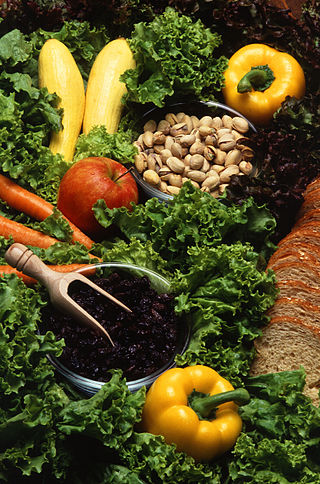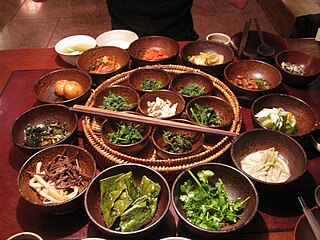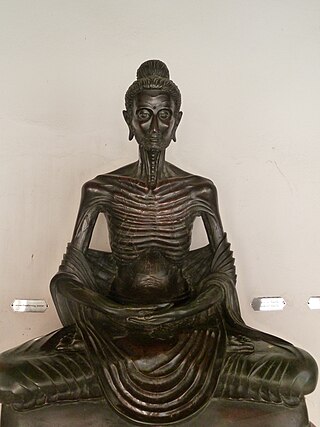
Japanese cuisine encompasses the regional and traditional foods of Japan, which have developed through centuries of political, economic, and social changes. The traditional cuisine of Japan is based on rice with miso soup and other dishes with an emphasis on seasonal ingredients. Side dishes often consist of fish, pickled vegetables, and vegetables cooked in broth. Common seafood is often grilled, but it is also sometimes served raw as sashimi or as sushi. Seafood and vegetables are also deep-fried in a light batter, as tempura. Apart from rice, a staple includes noodles, such as soba and udon. Japan also has many simmered dishes, such as fish products in broth called oden, or beef in sukiyaki and nikujaga.

Sangha is a Sanskrit word used in many Indian languages, including Pali which means "association", "assembly", "company" or "community"; In these languages, sangha is frequently used as a surname. In a political context, it was historically used to denote a governing assembly in a republic or a kingdom, and for a long time, it has been used by religious associations, including Buddhists, Jains and Sikhs. Given this history, some Buddhists have stated that the tradition of the sangha represents humanity's oldest surviving democratic institution.

Vegetarianism is the practice of abstaining from the consumption of meat. It may also include abstaining from eating all by-products of animal slaughter.

Vegetarian cuisine is based on food that meets vegetarian standards by not including meat and animal tissue products.

Chinese Buddhism or Han Buddhism is a Chinese form of Mahayana Buddhism which draws on the Chinese Buddhist canon as well as numerous Chinese traditions. Chinese Buddhism focuses on studying Mahayana sutras and Mahāyāna treatises and draws its main doctrines from these sources. Some of the most important scriptures in Chinese Buddhism include: Lotus Sutra, Flower Ornament Sutra, Vimalakirtī Sutra, Nirvana Sutra, and Amitābha Sutra. Chinese Buddhism is the largest institutionalized religion in mainland China. Currently, there are an estimated 185 to 250 million Chinese Buddhists in the People's Republic of China. It is also a major religion in Taiwan, Singapore, and Malaysia, as well as among the Chinese Diaspora.

Seitan is a food made from gluten, the main protein of wheat. It is also known as miànjīn, fu, milgogi, wheat meat, gluten meat, or simply gluten. It is made from vital wheat gluten, a flour-like substance primarily consisting of gluten extracted from wheat flour.
Buddhist culture is exemplified through Buddhist art, Buddhist architecture, Buddhist music and Buddhist cuisine. As Buddhism expanded from the Indian subcontinent it adopted artistic and cultural elements of host countries in other parts of Asia.

The Ōbaku-shū (黄檗宗) is one of three main schools of Zen in Japanese Buddhism, in addition to Sōtō and Rinzai. It had a strong influence on Japanese Rinzai, which partly adopted Ōbaku-practices, and partly reinstored older practices in response to the Ōbaku-school.

The City of Ten Thousand Buddhas is an international Buddhist community and monastery founded by Hsuan Hua, an important figure in Western Buddhism. It is one of the first Chan Buddhist temples in the United States, and one of the largest Buddhist communities in the Western Hemisphere.

The practice of vegetarianism is strongly linked with a number of religious traditions worldwide. These include religions that originated in India, such as Hinduism, Jainism, Buddhism, and Sikhism. With close to 85% of India's billion-plus population practicing these religions, India remains the country with the highest number of vegetarians in the world.

Buddhist monasticism is one of the earliest surviving forms of organized monasticism and one of the fundamental institutions of Buddhism. Monks and nuns, called bhikkhu and bhikkhuni, are responsible for the preservation and dissemination of the Buddha's teaching and the guidance of Buddhist lay people. Three surviving traditions of monastic discipline (Vinaya), govern modern monastic life in different regional traditions: Theravada, Dharmaguptaka, and Mulasarvastivada.

Jain vegetarianism is practised by the followers of Jain culture and philosophy. It is one of the most rigorous forms of spiritually motivated diet on the Indian subcontinent and beyond. The Jain cuisine is completely lacto-vegetarian and also excludes root and underground vegetables such as potato, garlic, onion etc., to prevent injuring small insects and microorganisms; and also to prevent the entire plant getting uprooted and killed. It is practised by Jain ascetics and lay Jains.

Buddhist vegetarianism is the practice of vegetarianism by significant portions of Mahayana Buddhist monastics and laypersons as well as some Buddhists of other sects. In Buddhism, the views on vegetarianism vary between different schools of thought. The Mahayana schools generally recommend a vegetarian diet, claiming that Gautama Buddha set forth in some of the sutras that his followers must not eat the flesh of any sentient being.

Buddhist ethics are traditionally based on the enlightened perspective of the Buddha. In Buddhism, ethics or morality are understood by the term Śīla or sīla (Pāli). Śīla is one of three sections of the Noble Eightfold Path. It is a code of conduct that embraces a commitment to harmony and self-restraint, primarily motivated by nonviolence or freedom from causing harm. It has been variously described as virtue, moral discipline and precept.

The position and treatment of animals in Buddhism is important for the light it sheds on Buddhists' perception of their own relation to the natural world, on Buddhist humanitarian concerns in general, and on the relationship between Buddhist theory and Buddhist practice.

Vegetarian and vegan dietary practices vary among countries. Differences include food standards, laws, and general cultural attitudes toward vegetarian diets.

The earliest records of vegetarianism as a concept and practice amongst a significant number of people are from ancient India, especially among the Hindus and Jains. Later records indicate that small groups within the ancient Greek civilizations in southern Italy and Greece also adopted some dietary habits similar to vegetarianism. In both instances, the diet was closely connected with the idea of nonviolence toward animals, and was promoted by religious groups and philosophers.

This article traces the history of cuisine in Japan. Foods and food preparation by the early Japanese Neolithic settlements can be pieced together from archaeological studies, and reveals paramount importance of rice and seafood since early times.

Kaiseki (懐石) or kaiseki-ryōri is a traditional multi-course Japanese dinner. The term also refers to the collection of skills and techniques that allow the preparation of such meals and is analogous to Western haute cuisine.

In Buddhism, there are a variety of attitudes towards different forms of fasting. The Buddha is known to have practiced extreme forms of fasting which led to his emaciation and to have famously abandoned it before his great awakening. Nevertheless, different forms of fasting are practiced in various Buddhist traditions.




















